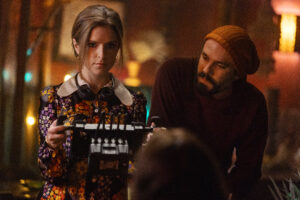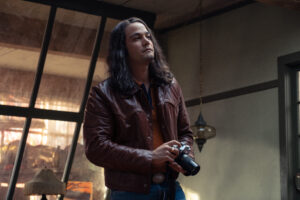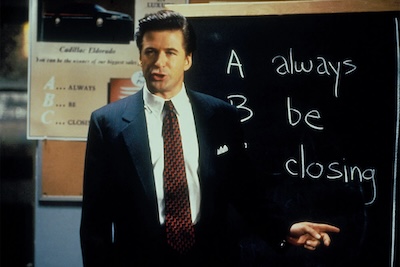The Dating Game presented a fantasy world to the American public. That illusion comes center stage in Anna Kendrick’s breathlessly great thriller, Woman of the Hour, a stranger than fiction account of how a serial killer became an eligible bachelor on one of the biggest game shows in modern American teleivision. Do we forget that everyone on television is produced? Think about how women want to dress themselves versus how men and society expect them to dress in order to be pursued–or in order to stay safe. For costume designers Brooke Wilcox and Sekyiwa Wi-Alfedzi, balancing the real misogyny of the real world with the glossy facade of television was a big undertaking.
There 1970’s were an experimental time for a variety of reasons, but one could say that clothing was at the forefront of the mood of the nation. People weren’t afraid of color or outrageous designs–the patterns, my word, the patterns. Woman of the Hour allowed this pair to embrace something they absolutely adore…
“Vintage is our scene,” Wi-Afedzi says.
“We don’t get to use it as much as we like, because when you need multiples of everything, it makes it more challenging,” Wilcox says.
“So when we can use it, we really love going off,” Wi-Afedzi adds. “We started on the Internet and then we went deep on books in the library. The silhouette, for both men and women, changes from the beginning of the decade to the end of the decade. If you notice the time cuts, the film jumps around a lot, and that was interesting for us. Coming into the ’70s, it was time for men to shine–the peacock revolution, they called it. They were wearing, for instance, a Cuban heel and a flared collar before becoming more austere toward the end of the decade. The soul of the silhouette started to have a broad shoulder and a narrower waist and the collar started to point more.”
“We had to really balance the time period to make sure we weren’t going too far in places,” Wilcox says. “Did something feel a little too 1975 in one place? Should we pull back? We were trying to match that with things that were current to sort of manipulate it to look like it was the period. There was some tweaking where we took something a bit more contemporary and modifying the silhouette to reflect our need and get comfortable in the decade.”

In general, I think men need to play around more with what they put on their bodies, and they can certainly get some inspiration from the costumes of Woman of the Hour. Men exuded a condfidence because they exclusively held all the power, but some characters are stuck even further back in the past.
“We got to flex more with Tony Hale’s character, who was this almost stereotypical game show host,” Wi-Afedzi. “Loud and clownish while also being extremely coordinated. Some of those hosts, back then, were really verging on ridiculous.”
“We sourced it all in Vancouver and it was interesting because I think a lot of people thought that we couldn’t find that much vintage within the city,” Wilcox says.
“We’re talking trunks that probably hadn’t been opened in fifty years,” Wi-Afedzi says. “People dry cleaned their clothes and put them away or someone passed away and there was an estate sale with untouched clothes.”
When we first meet Kendrick’s Cheryl, she is attending yet another audition, and it feels like she wears the same thing to every meeting. She wears a patterned, brown jacket with a tomato turtleneck and a gold pendant. This is how Cheryl wants to project herself as a performer, and, as we see later, it’s different than how people would expect her to dress.
“We mood boarded an Annie Hall vibe,” Wi-Afedzi says. “Harris tweed but not totally androgynous. It didn’t have to emphasize her femininity–there’s some modesty. She wanted to really be taken seriously as a professional, and Cheryl is trying to dress that part even if she ends up being perceived as someone who was unsexy. Clearly, those two casting agents at the beginning of the film are talking about her like she’s not there.”
“It feeds well into a situation where a character feels like they are wearing layers as an armor,” Wilcox says. “Anna was the one we were doing fittings with, and she was the one that made all the selects for the costumes. That was something that she had such inpit with, so it was nice to work her to find what was comfortable to help her find her character in that moment.”
When Cheryl arrives at the studio of The Dating Game, she sports a black dress with a hint of a floral pattern and a white collar underneath a gorgeous red, leather coat. What she doesn’t realize is that the show will place her in an entirely different outfit. On camera, Cheryl wears an orange and pink dress that hugs her figure more, and the neckline is lower than anything else we’ve seen her wear throughout the beginning of the film. Wilcox and Wi-Afedzi gets so excited when they talk about options for that black dress that I am hoping Netflix releases a small coffee table book just of what the designers considered.

“We had some reference images of the actual moments and the actual dress that Cheryl wore and what the real Rodney Alcala wore,” Wi-Afedzi says. “Anna wanted us to hafe a little bit of freedom to be creative to make it a departure from Cheryl’s everyday wardrobe.”
“Our production designer, Brent Thomas, was really awesome, and we talked with him a lot,” Wilcox says. “We checked in with him a lot in terms of the color palette because, with such bright colors, we really wanted to make sure that it was cohesive and that it made sense.”
“The pattern that we went with was almost more reflective of Tony’s character,” Wi-Afedzi says. “This was the late ’70s at this point, but she was wearing a pattern that was definitely earlier in the decade which is where his character is stuck. Big swirls, psychedelic elements; it had to be a departure from what Cheryl would normally wear while still making her look beautiful and feminine.”
“We wanted it to be markedly different from Cheryl’s personal choices,” Wilcox says.
“There’s something completely not sensible about it,” Wi-Afedzi adds. “With the darker dress with the big collar, there were actually a few that we found at one of those incredible estate sales. A teenager had put her clothes away, and I don’t think her trunk had been opened for years–it was up in someone’s attic.”
When it came to dressing Rodney Alcala, the designers wanted to go more casual with his looks. Every time we see him again in a flashback, he is wearing a different jacket. First it’s corduroy then leather then denim. Is he shedding his skin or nervous to be caught wearing the same thing twice? Wilcox and Wi-Afedzi reveal that he had to be relatable.
“He’s a chameleon to lure different women in all kinds of situations,” Wilcox says. “He’s looking for low-hanging fruit, so he’s ging to make himself as accessible and relatable as possible. That person changes over time. We tried to stick to a more casual kind of cool.”
“He wasn’t trying to be aspirational in any way, and he was somebody was clearly ruled by his ego,” Wi-Afedzi says. “We talked a lot about trying to find those evolutions but still have an accessibility and relatability to him so you can see yourself in his clothing. He might be in a ringer T-shirt or a pair of beat up jeans with his camera bag.”
This decade is so rich in texture and fabric that I want so many items for myself. Even though the casting directors at the beginning of the film are sleazy, I want both the green turtleneck and the patterned button-up. This pair had a lot to choose from.
“We have so much in our costume kit that we are contantly trying to downsize,” Wilcox says, with a laugh.
“I love the green, suede vest with a huge buckle that Nicolette [Robinson] wears,” Wi-Afedzi says. “It’s so off the time.”
“I love Anna’s moving look,” Wilcox says. “That’s super cute.”
Woman of the Hour is streaming now on Netflix.









